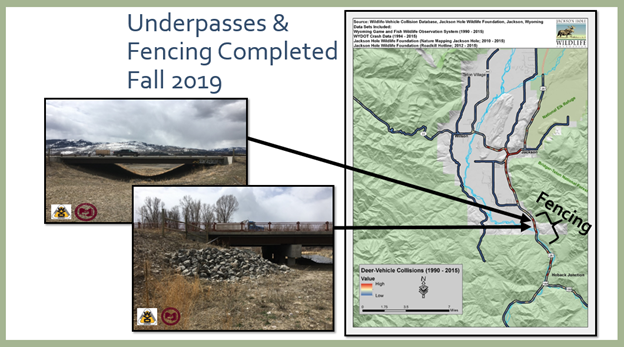By Dr. Hannah Specht, University of Montana
Citizen scientists, the world round, invest in data collection on the understanding that this effort will contribute to expanding knowledge and the hope that it will move us forward. The timeline for knowledge expansion, and the application of that knowledge, however, can be painfully slow…sometimes long enough that we’ve forgotten about that long-ago data collection. Here, I want to take a moment to tell you about how some citizen science efforts have shaped both knowledge and action to the benefit of wildlife and humans alike near Jackson, Wyoming.
First, who am I that I have something to say about this? My name is Hannah Specht and I work as a wildlife research scientist at the University of Montana. One of the projects I work on is helping with the data analysis from the post-construction monitoring of wildlife collision reduction and movement infrastructure incorporated into the I-89 highway renovation between Jackson and Hoback Junction. Enter, citizen science data that many of you have been involved in collecting! For one, the locations of wildlife underpasses near the WYDOT yard and along Flat Creek were identified as being in areas with higher deer collision rates based on collision hotspot maps produced by Jackson Hole Wildlife Foundation. These maps were based on data from Nature Mapping Jackson Hole as well as WYDOT Crash Data (both of which citizen scientists contribute to). Further, a collaborative initiative supported by volunteers did some pre-construction wildlife camera trapping at the locations where wildlife underpasses were installed, providing us with some baseline knowledge of the animal community. Finally, continued collision reporting has allowed us to compare collision rates before and after the wildlife crossing structures and fencing were installed.
So, what insight have these citizen science efforts offered us? The most important insight is that there were 30% fewer collisions between vehicles and large animals (elk, deer, moose) between Hoback and Jackson in just the first winter (2019-2020) that the underpass and fencing were installed (with the fencing extending only ~30% of the distance). We estimate that this reduction could represent up to $200k in cost savings to the community. We expect that, with additional time to get used to the crossing structures, these numbers will improve even more—we’re eager to update these analyses when the 2021 collision data are available! And, even now that underpasses and fences are installed, there are still problem points that collision reporting helps to identify.

In the first year since the wildlife underpasses were completed, we’ve seen a very similar suite of wildlife species using the underpasses as those that were using the area before underpass construction—we’re able to know this because of the camera trapping work conducted before underpass construction by JHWF and other collaborators.
When it comes down to it, growing our knowledge of wildlife and wildlife-human interactions often requires a lot of data across time and covering a large area, frequently beyond the scope of one organization. Citizen science exemplifies what we are capable of, together. Nevertheless, we are all naturally curious about what our collaborative efforts lead to, and in the context of citizen science, we don’t always get to know because sometimes that information doesn’t get used until years later. In other parts of my work, I draw on nature observations submitted to programs like iNaturalist, eBird and eMammal to design wildlife surveys- and it is constantly clear how valuable those data are in making our survey efforts more efficient and effective. So, as a user of citizen science data, I’m here to say thank you for the ways in which your participation in citizen science helps us learn things in later moments, even if we don’t always know ahead of time when those moments will be.
